Articles
- Page Path
- HOME > J Korean Acad Nurs > Volume 45(4); 2015 > Article
-
Original Article
- Validity and Reliability of ARQ-K (Korean Version of the Assault Response Questionnaire) for Emergency Department Nurses in Korea
- Moon Jung Jang, Eun Nam Lee
-
Journal of Korean Academy of Nursing 2015;45(4):544-553.
DOI: https://doi.org/10.4040/jkan.2015.45.4.544
Published online: August 31, 2015
Department of Nursing, Dong-A University, Busan, Korea.
- Address reprint requests to: Lee, Eun Nam. Department of Nursing, Dong-A University, 32 Daesingongwon-ro, Dongdaesin-dong 3(sam)-ga, Seo-gu, Busan 49201, Korea. Tel: +82-51-240-2864, Fax: +82-51-240-2947, enlee@dau.ac.kr
© 2015 Korean Society of Nursing Science
This is an Open Access article distributed under the terms of the Creative Commons Attribution NoDerivs License. (http://creativecommons.org/licenses/by-nd/4.0/) If the original work is properly cited and retained without any modification or reproduction, it can be used and re-distributed in any format and medium.
Abstract
-
Purpose
- To investigate the validity and reliability of the Korean Version of the Assault Response Questionnaire (ARQ-K) measuring the intensity of reaction to victimization of emergency nurses in Korea.
-
Methods
- An internal consistency reliability and construct validity using exploratory and confirmatory factor analysis were conducted using SPSS WIN (20.0) and AMOS (20.0). Survey data were collected from 321 nurses who worked in 3 levels - wide regional emergency centers, regional emergency centers, appointed emergency centers - of emergency care facilities in Busan, Korea.
-
Results
- The Cronbach's alpha values regarding internal consistency were .77~.93 for the subscales of ARQ-K. Factor loadings of the 26 items on the four subscales ranged from .59 to .84. The four-subscale model was validated by confirmatory factor analysis (χ2/df=3.85, p < .001, RMR=.06, GFI=.80, NFI=.81, TLI=.83, CFI=.85, RMSEA=.09).
-
Conclusion
- This study shows that the Korean Version of the Assault Response Questionnaire is a valid and reliable instrument to assess nurses' reaction to victimization of emergency nurses in Korea.
- 1. Erickson L, Williams-Evans SA. Attitudes of emergency nurses regarding patient assaults. J Emerg Nurs. 2000;26(3):210–215.ArticlePubMed
- 2. Gates DM, Gillespie GL, Succop P. Violence against nurses and its impact on stress and productivity. Nurs Econ. 2011;29(2):59–66.PubMed
- 3. International Council of Nurses. Abuse and violence against nursing personnel [Internet]. Geneva, CH, International Council of Nurses. 2014;cited 2014 November 30. Available from: http://www.icn.ch/images/stories/documents/publications/position_statements/C01_Abuse_Violence_Nsg_Personnel.pdf
- 4. Park MW. Protection of hospital workers' rights is weak. Seoul, Medical Today. 2014;cited 2014 November 30. Available from: http://www.mdtoday.co.kr/mdtoday/?no=245852
- 5. Kim SY, Eom M, Oh HY, Ahn HY. Violence episodes and responses of emergency room nurses. J Korean Acad Fundam Nurs. 2007;14(4):446–456.
- 6. Mahoney BS. The extent, nature, and response to victimization of emergency nurses in Pennsylvania. J Emerg Nurs. 1991;17(5):282–294.PubMed
- 7. Needham I, Abderhalden C, Halfens RJ, Fischer JE, Dassen T. Non-somatic effects of patient aggression on nurses: A systematic review. J Adv Nurs. 2005;49(3):283–296. ArticlePubMed
- 8. Lanza ML. The reactions of nursing staff to physical assault by a patient. Hosp Community Psychiatry. 1983;34(1):44–47.ArticlePubMed
- 9. Lanza ML, Zeiss RA, Rierdan J. Non-physical violence: A risk factor for physical violence in health care settings. AAOHN J. 2006;54(9):397–402.PubMed
- 10. Lanza ML. Nurses as patient assault victims: An update, synthesis, and recommendations. Arch Psychiatr Nurs. 1992;6(3):163–171.ArticlePubMed
- 11. Lanza ML, Shattell MM, MacCulloch T. Assault on nursing staff: Blaming the victim, then and now. Issues Ment Health Nurs. 2011;32(8):547–548. ArticlePubMed
- 12. Trossman S. Not 'part of the job'. Nurses seek an end to workplace violence. Am Nurse. 2010;42(6):1.
- 13. Poster EC. A multinational study of psychiatric nursing staffs' beliefs and concerns about work safety and patient assault. Arch Psychiatr Nurs. 1996;10(6):365–373.Article
- 14. Needham I, Abderhalden C, Halfens RJ, Dassen T, Haug HJ, Fischer JE. The Impact of Patient Aggression on Carers Scale: Instrument derivation and psychometric testing. Scand J Caring Sci. 2005;19(3):296–300. ArticlePubMed
- 15. Whittington R, Wykes T. Staff strain and social support in a psychiatric hospital following assault by a patient. J Adv Nurs. 1992;17(4):480–486.ArticlePubMed
- 16. Lanza ML. Assault response questionnaire. Issues Ment Health Nurs. 1988;9(1):17–29.ArticlePubMed
- 17. Yang JH, Jung HY. Relationship between violence response, coping, and burnout among emergency department nurses. J Korean Acad Fundam Nurs. 2009;16(1):103–111.
- 18. Croker K, Cummings AL. Nurses' reactions to physical assault by their patients. Can J Nurs Res. 1995;27(2):81–93.PubMed
- 19. Lu CH, Wang TF, Liu CY. Psychiatric nurses' reactions to assault upon them by inpatients: A survey in Taiwan. Psychol Rep. 2007;100(3 Pt 1):777–782. ArticlePubMedPDF
- 20. Bryant FB, Yarnold P. Principal components analysis and exploratory and confirmatory factor analysis. In: Grimm LG, Yarnold PR, editors. Reading and understanding multivariate statistics. Washington, DC: American Psychological Association; 1995. p. 99–136.
- 21. Weiss DS, Marmar CR. The Impact of Event Scale-Revised. In: Wilson J, Keane T, editors. Assessing psychological trauma and PTSD. New York, NY: The Guilford Press; 1997. p. 399–411.
- 22. Eun HJ, Kwon TW, Lee SM, Kim TH, Choi MR, Cho SJ. A study on reliability and validity of the Korean Version of Impact of Event Scale-Revised. J Korean Neuropsychiatr Assoc. 2005;44(3):303–310.
- 23. Lee EO, Lim NY, Park HA, Lee IS, Kim JI, Bae J, et al. Nursing research and statistics. Paju: Soomoonsa; 2009.
- 24. Yu JP. The concept and understanding of structural equation modeling. Seoul: Hannare Publishing Co.; 2012.
- 25. Harrington D. Confirmatory factor analysis: Pocket guides to social work research methods. New York, NY: Oxford University Press; 2009.
- 26. Rice VH. Handbook of stress, coping, and health: Implications for nursing research, theory, and practice. 2nd ed. Thousand Oaks, CA: Sage Publications; 2012.
- 27. Blanchard JC, Curtis KM. Violence in the emergency department. Emerg Med Clin North Am. 1999;17(3):717–731.ArticlePubMed
- 28. Choi WJ, Cho SH, Cho NS, Kim GS. Effect of an education program on violence in the emergency department. J Korean Soc Emerg Med. 2005;16(2):221–228.
- 29. Bae BR. Structural equation modeling with Amos 19: Principles and practice. Seoul: Chungram Books; 2011.
- 30. Hair JF, Tatham RL, Anderson RE, Black W. Multivariate data analysis. 5th ed. Upper Saddle River, NJ: Prentice Hall; 1998.
REFERENCES
Figure & Data
REFERENCES
Citations

- The Influence of Violence Experience, Violence Response and Coping with Violence on Professional Quality of Life among Emergency Department Nurses
Eunju Choi, Youngjin Lee
Journal of Korean Academy of Nursing Administration.2024; 30(2): 91. CrossRef - High-Risk Symptom Cluster Groups for Work-Life Quality and Turnover Intention among Nurses
Chiyoung Cha, Miran Lee
Western Journal of Nursing Research.2023; 45(3): 192. CrossRef - Effects of Clinical Nurses' Responses to Violence on Burnout: The Moderating Role of Positive Psychological Capital
Haejun Choi, Sujin Shin, Seungji Kim, Sungran Kim
Korean Journal of Adult Nursing.2023; 35(4): 406. CrossRef - Experience of Violence and Factors Influencing Response to Violence Among Emergency Nurses in South Korea: Perspectives on Stress-Coping Theory
Seung-Yi Choi, Hyunlye Kim, Kwang-Hi Park
Journal of Emergency Nursing.2022; 48(1): 74. CrossRef - Verbal violence and turnover intention among new nurses in Korea: A time‐lagged survey
Ae Kyung Chang, Ah Young Kim
Journal of Nursing Management.2022; 30(6): 1823. CrossRef - Factors Affecting on Turnover Intentions of Emergency Department Nurses who have Experienced Verbal Abuse
Gyoo-Yeong CHO, Mi-Kyung SEO
JOURNAL OF FISHRIES AND MARINE SCIENCES EDUCATION.2021; 33(2): 314. CrossRef - Validity and reliability of Korean version of the Grit Scale for Korean nursing students
Hyo-Suk Song, So-Hee Lim
The Journal of Korean Academic Society of Nursing Education.2020; 26(3): 322. CrossRef - Effects of Hospital-Based Violence-Prevention and Coping Programs on Nurses' Violence Experience, Violence Responses, Self-Efficacy, and Organizational Commitment
Yu Jeong Yang, Jeong-Hee Kim
Journal of Korean Academy of Nursing Administration.2020; 26(5): 550. CrossRef - Investigating the moderating effects of multi group on safety performance: The case of civil aviation
Vedant Singh, Somesh Kumar Sharma, Indu Chadha, Tej Singh
Case Studies on Transport Policy.2019; 7(2): 477. CrossRef - The Moderating Effect of Social Support on the Relationship between Violence Experiences and Violence Responses of Psychiatric Nurses
Jinhee Kim
Journal of Korean Academy of Psychiatric and Mental Health Nursing.2019; 28(2): 144. CrossRef - Experience of Violence from the Clients and Coping Methods Among Intensive Care Unit Nurses Working in a Hospital in South Korea
Hye Jin Yoo, Eunyoung E. Suh, Soon Haeng Lee, Jin Hee Hwang, Ji Hye Kwon
Asian Nursing Research.2018; 12(2): 77. CrossRef - Mediating Effect of Resilience on the Association between Violence Experience and Violence Response among Nurses
Cheol Jeong, Eun Nam Lee
Korean Journal of Adult Nursing.2018; 30(1): 41. CrossRef - Hardiness Mediates Stress and Impact Level in ED Nurses Who Experienced a Violent Event
Jin Hee Park, Eun Nam Lee, Kyung Ran Kong, Moon Jung Jang
Journal of Emergency Nursing.2017; 43(6): 539. CrossRef - Convergent approach of phenomenological methodology about Emergency Nurses' experience of hospital violence
Young-Hee Jeong
Journal of the Korea Convergence Society.2015; 6(5): 63. CrossRef
General Characteristics of Participants (N=321)
*Multiple responses; ED=Emergency department; WREC=Wide regional emergency center; REC=Regional emergency center; AEC=Appointed emergency center.
Factor Loading from Exploratory Factor Analysis for ARQ
ARQ=Assault response questionnaire.
Confirmatory Factor Analysis Results and Final Items for ARQ-K
ARQ-K=Korean version of assault response questionnaire; RMR=Root mean square residual; GFI=Goodness of fit index; NFI=Normed fit index; TLI=Tucker-lewis index; CFI=Comparative fit index; RMSEA=Root mean square error of approximation.
Correlations between ARQ-K and IES-R-K
ARQ-K=Korean version of assault response questionnaire; IES-R-K=Korean version of impact of event scale-revised.
Reliability for ARQ-K and Mean Score for the Each Item
ARQ-K=Korean version of assault response questionnaire.
*Multiple responses; ED=Emergency department; WREC=Wide regional emergency center; REC=Regional emergency center; AEC=Appointed emergency center.
ARQ=Assault response questionnaire.
ARQ-K=Korean version of assault response questionnaire; RMR=Root mean square residual; GFI=Goodness of fit index; NFI=Normed fit index; TLI=Tucker-lewis index; CFI=Comparative fit index; RMSEA=Root mean square error of approximation.
ARQ-K=Korean version of assault response questionnaire; IES-R-K=Korean version of impact of event scale-revised.
ARQ-K=Korean version of assault response questionnaire.
 KSNS
KSNS
 E-SUBMISSION
E-SUBMISSION
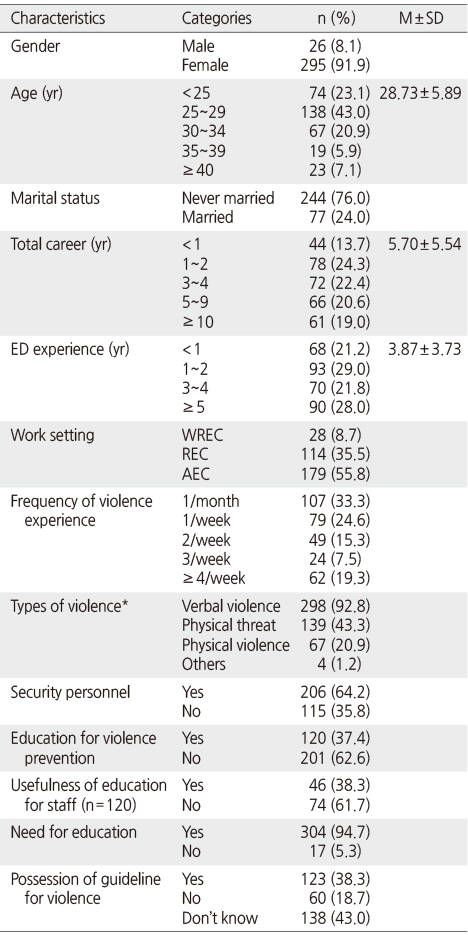
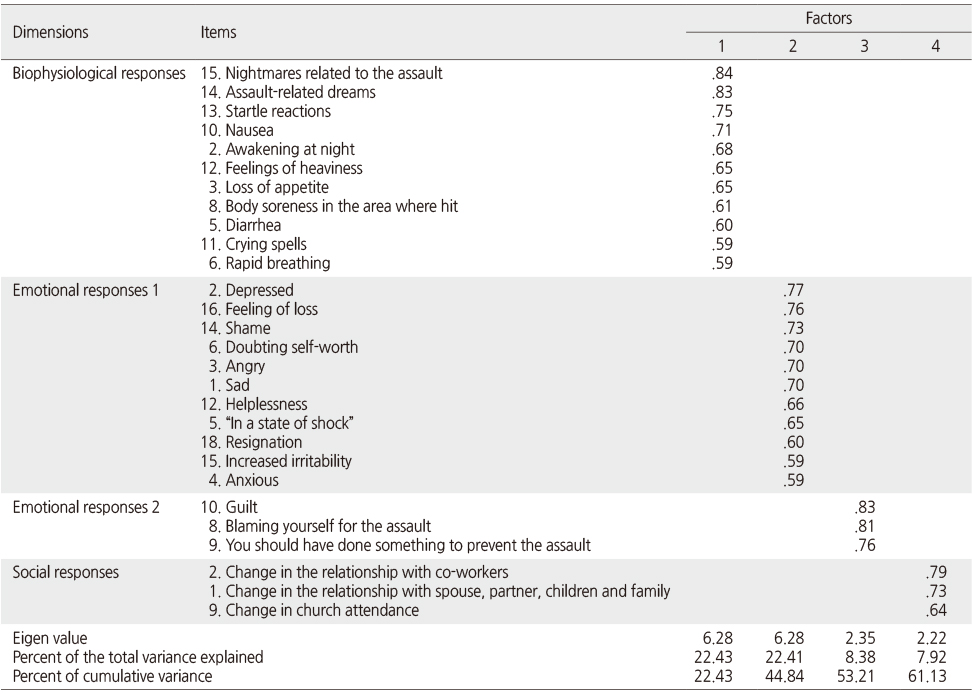
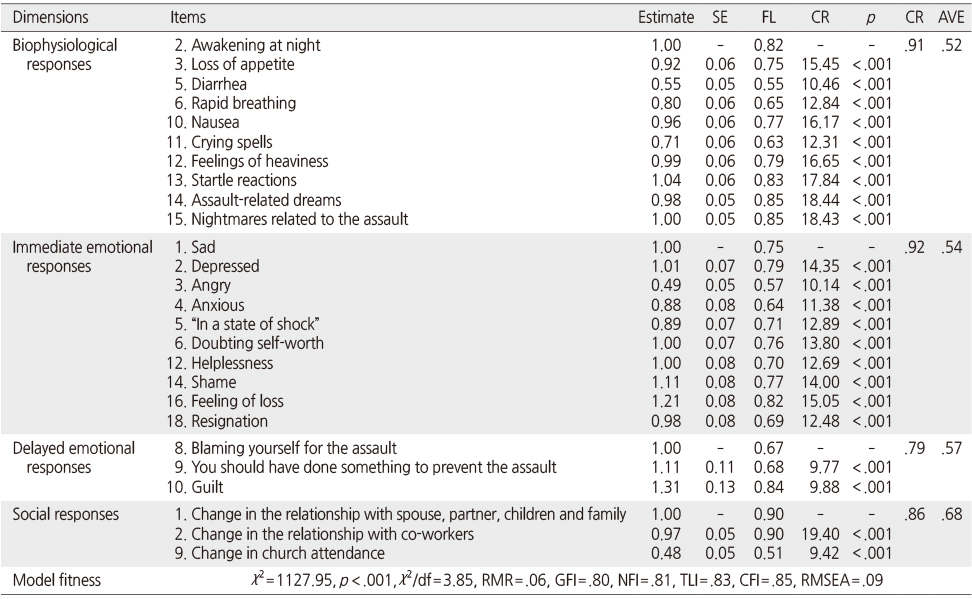
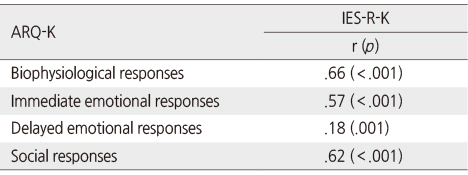
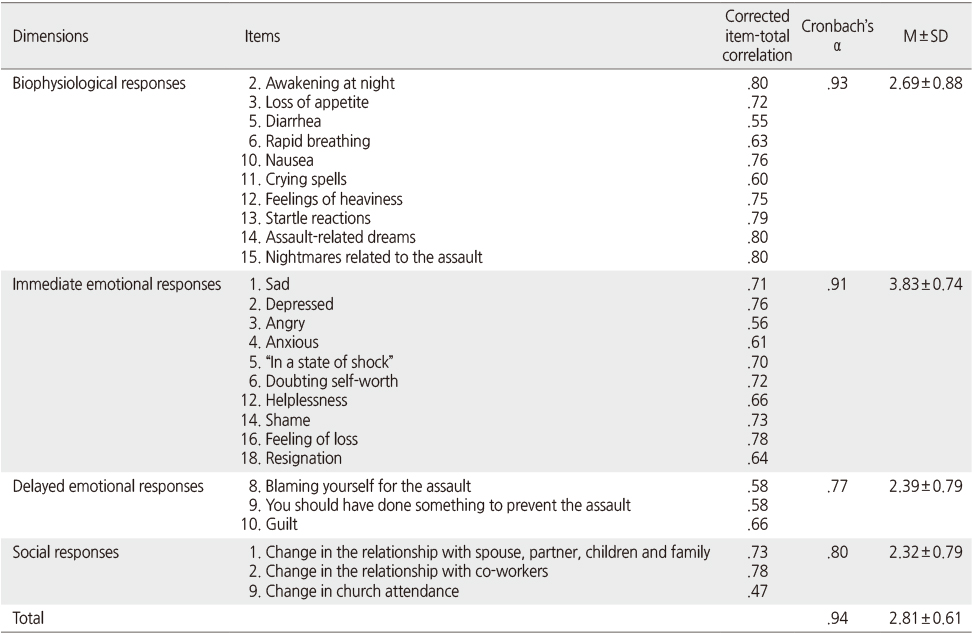
 Cite
Cite

